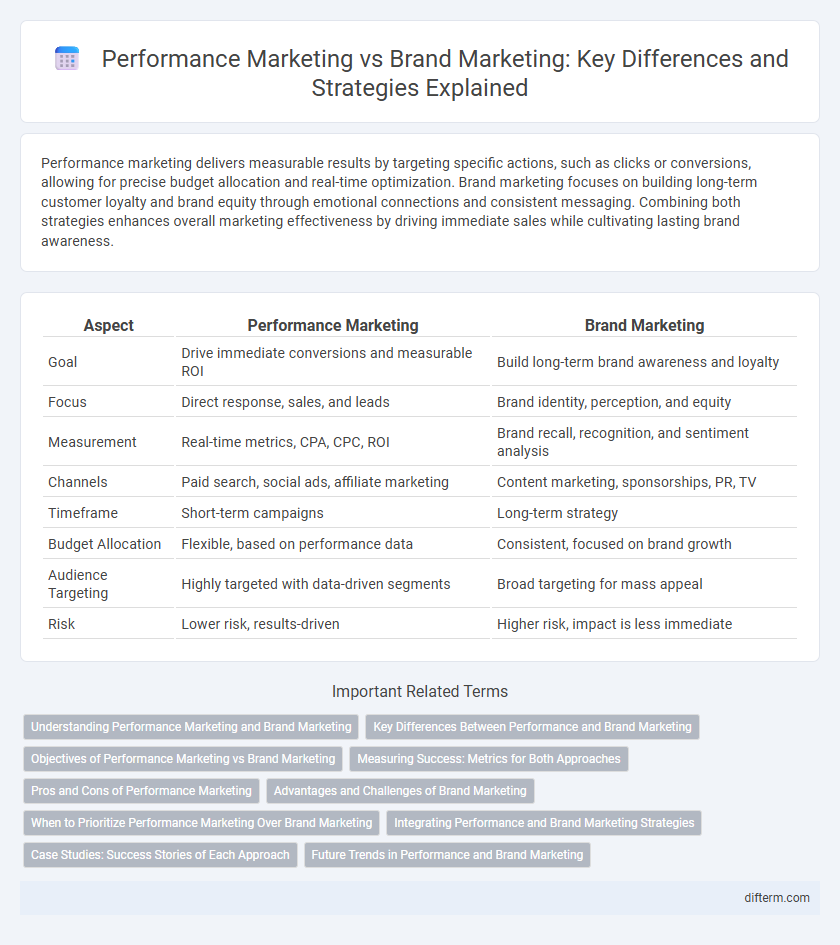Performance marketing delivers measurable results by targeting specific actions, such as clicks or conversions, allowing for precise budget allocation and real-time optimization. Brand marketing focuses on building long-term customer loyalty and brand equity through emotional connections and consistent messaging. Combining both strategies enhances overall marketing effectiveness by driving immediate sales while cultivating lasting brand awareness.
Table of Comparison
| Aspect | Performance Marketing | Brand Marketing |
|---|---|---|
| Goal | Drive immediate conversions and measurable ROI | Build long-term brand awareness and loyalty |
| Focus | Direct response, sales, and leads | Brand identity, perception, and equity |
| Measurement | Real-time metrics, CPA, CPC, ROI | Brand recall, recognition, and sentiment analysis |
| Channels | Paid search, social ads, affiliate marketing | Content marketing, sponsorships, PR, TV |
| Timeframe | Short-term campaigns | Long-term strategy |
| Budget Allocation | Flexible, based on performance data | Consistent, focused on brand growth |
| Audience Targeting | Highly targeted with data-driven segments | Broad targeting for mass appeal |
| Risk | Lower risk, results-driven | Higher risk, impact is less immediate |
Understanding Performance Marketing and Brand Marketing
Performance marketing focuses on measurable, data-driven campaigns to drive immediate actions such as clicks, leads, or sales, emphasizing direct ROI and conversion tracking. Brand marketing aims to build long-term brand equity, awareness, and customer loyalty through storytelling, emotional connection, and consistent messaging across multiple channels. Understanding the distinct goals, metrics, and strategies of performance marketing versus brand marketing enables businesses to allocate resources effectively and achieve both short-term results and sustained brand growth.
Key Differences Between Performance and Brand Marketing
Performance marketing targets measurable actions such as clicks, conversions, and sales using data-driven campaigns to optimize ROI in real time. Brand marketing emphasizes long-term relationship building, focusing on brand awareness, loyalty, and emotional connection to influence consumer perception over time. Key differences include their objectives, measurement methods, and timeframes, with performance marketing driven by immediate results and brand marketing aimed at sustained growth.
Objectives of Performance Marketing vs Brand Marketing
Performance marketing prioritizes measurable outcomes such as leads, conversions, and return on ad spend (ROAS) to drive immediate sales growth. Brand marketing emphasizes building long-term brand awareness, loyalty, and emotional connection with the target audience to enhance overall market position. The primary objective of performance marketing is direct, quantifiable impact on revenue, while brand marketing aims to create sustained customer equity and reputation.
Measuring Success: Metrics for Both Approaches
Performance marketing success is measured through direct, quantifiable metrics such as cost per acquisition (CPA), return on ad spend (ROAS), conversion rates, and click-through rates (CTR). Brand marketing relies on metrics like brand awareness, brand recall, customer sentiment, and net promoter score (NPS) to evaluate long-term impact and emotional connection. Combining these metrics provides a comprehensive view of marketing effectiveness by balancing short-term results with sustained brand growth.
Pros and Cons of Performance Marketing
Performance marketing offers measurable ROI through real-time data tracking and targeted campaigns, enabling marketers to swiftly optimize budgets and strategies for maximum conversions. This approach excels in driving immediate sales and generating actionable insights but often sacrifices long-term brand loyalty and emotional connection with consumers. The reliance on short-term metrics can limit brand equity development and may lead to increased customer acquisition costs over time.
Advantages and Challenges of Brand Marketing
Brand marketing builds long-term customer loyalty and enhances brand equity by creating emotional connections and strong brand recognition. It faces challenges such as slower measurable ROI and difficulty attributing direct sales, requiring consistent messaging and investment over time. Effective brand marketing drives sustained growth through trust and differentiation in competitive markets.
When to Prioritize Performance Marketing Over Brand Marketing
Performance marketing should be prioritized when measurable return on investment (ROI) is critical, such as during product launches, promotional campaigns, or limited-time offers requiring immediate customer actions like clicks, sign-ups, or purchases. Brands aiming for rapid growth, customer acquisition, or optimizing digital ad spend benefit from data-driven strategies and real-time analytics inherent in performance marketing. This approach ensures marketing budgets deliver quantifiable results, enabling agile adjustments to maximize conversions and sales velocity.
Integrating Performance and Brand Marketing Strategies
Integrating performance marketing and brand marketing strategies enhances overall campaign effectiveness by combining data-driven tactics with long-term brand building. Leveraging customer insights and real-time analytics from performance marketing supports informed brand messaging that resonates deeply with target audiences. Unified approaches drive both immediate conversions and sustained brand loyalty, optimizing return on marketing investment across multiple channels.
Case Studies: Success Stories of Each Approach
Case studies reveal performance marketing's strength in driving measurable ROI through targeted campaigns on platforms like Google Ads and Facebook, exemplified by companies like Airbnb achieving rapid user acquisition and sales growth. Brand marketing success stories such as Nike's long-term investment in storytelling and emotional connections enhance customer loyalty and global brand equity. These approaches highlight distinct advantages: performance marketing excels in short-term conversions while brand marketing builds sustained market presence over time.
Future Trends in Performance and Brand Marketing
Future trends in performance marketing emphasize leveraging AI-driven data analytics to optimize real-time ad targeting and personalized customer experiences, boosting ROI and conversion rates. Brand marketing is increasingly integrating immersive technologies like augmented reality and interactive content to enhance emotional engagement and long-term brand loyalty. Both strategies are converging through advanced attribution models and unified marketing platforms, enabling seamless synergy between immediate performance metrics and sustained brand equity growth.
Performance marketing vs brand marketing Infographic

 difterm.com
difterm.com